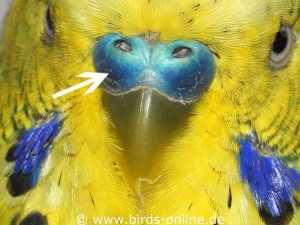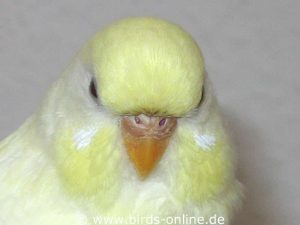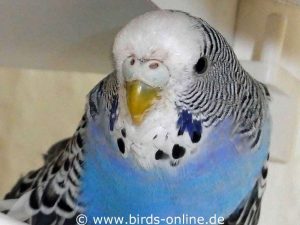- >>
- Birds Online – English
- >>
- General facts
- >>
- How to identify your...
How to identify your budgie’s sex

Finding out the sex of your budgies is relatively simple in most cases – at least in adult and sexually mature birds. Depending on the color variety and health-condition of a budgie, however, the sex-determination can turn out as difficult in individual cases. Furthermore, it’s often not easy to recognize the sex of birds who are not yet sexually mature. In this chapter, you will learn what you have to pay attention to.
Small details you should know

The most important (and only) externally visible feature, by which one can recognize the sex of a budgie, is the color of the so-called cere. That’s how the skin that covers the nose of a budgie is called. The coloring of the cere tells you whether a bird is male or female. But things aren’t that easy in every case. This coloration can be confusing because it doesn’t just depend on the sex but also the color variety of a bird and its general health status.
A less reliable clue is the behavior. Because against the statement of some literature sources singing and performing courtship display is by no means only shown by male individuals. Many female birds also sing and display – and there are male birds who don’t like to sing that much. In extreme cases, the female birds are so dominant and daring that they even try to climb on their partner’s back like the males generally do when mating. What the females do is no mating attempt but a dominant gesture. It can be very confusing for us and make us think that a girl is a boy.

It’s often stated that a budgie who bites very firmly is female. The females are known for being able to bite quite powerfully. So, it tends to be true that females often have a much stronger bite than male budgies, but there are also exceptions to this rule. Therefore, bird owners should not torture themselves by enduring bite tests for sex determination. Forget about all this behavior stuff and take a very close look at your budgie’s nose instead.
Blue, pink, whitish, brown – info in brief
At first, I’d like to provide you with a summary of the different colorings that can occur. Further down on this page you will find more detailed information.
For the adult (thus sexually mature), healthy budgies, the following simple rule applies in the majority of the cases: Females have a brown cere, the males a shiny blue one.
In some color varieties the cere of the males is not colored blue, but either completely pink or pink-blue pied.
Regarding female budgies, you have to consider an important thing: The brown coloring of the cere indicates that the bird is in a physically good condition and prepared for breeding in case you allow your birds to raise chicks. If, on the other hand, a sexually mature female is hormonally inactive, which can occur either spontaneously and without serious cause like due to a disease that weakens the organism, the cere often is light blue to whitish blue.
That means occasionally the cere of a female budgie changes its color from whitish-blue to brown or the other way round. This is a hormone-controlled process and it is by no means the case that the animal changes its sex, as some people claim. No bird can ever do so! So please keep in mind that a light blue cere is common for a female who is not in breeding condition, whereas males have a shiny blue to dark blue cere. And that’s what you should consider always: It’s the intensity of the blue coloration that makes the difference!
Recognize mature female budgies in breeding condition
Healthy, adult females, who are in breeding condition show their fitness by a soft brown to chocolate brown cere. When the breeding mood is particularly intense or lasts for too long, the cere often becomes crusty and bulged. Veterinarians call it a hyperkeratosis of the cere. To make sure that the bird is not seriously ill instead, an avian vet should be consulted if your bird’s cere bugles.
Recognize hormonally inactive mature female budgies
If the cere is colored light-brown to whitish-brown, the female is only moderately in breeding condition. With light-blue to whitish coloring, the female in most cases is hormonally inactive. There can be several reasons for this, for example, that the animal is seriously ill.
The disease can affect the organism of a female budgie and cause the production of estrogen (the primary female sex hormone) to be reduced. This affects the coloration of the cere: If an adult bird’s cere is colored in a delicate light blue over a very long period (two to several months), it is most likely a female that has either survived a long, serious illness, a bird who is still ill or one who suffers from a general hormone disorder.
However, occasionally healthy females also have a very light-blue cere due to their color variety and thus not because they’re ill. Birds with very light or purely white plumage tend to have a bright cere as well. Nevertheless, a sexually mature female who has a whitish to very light blue cere for a long time should be examined by an avian vet – just to be safe than sorry.
Recognize mature male budgies
In general, male budgies have a blue cere. But it’s not always colored with the same intensity depending on the individual current hormone and health status. This difference in color caused by the breeding condition isn’t as noticeable as we know that from the female budgies. If healthy sexually mature males are in breeding condition, the cere is usually smooth and shining blue. On the other hand, it may look a bit dull and be colored less intensively in case a male bird is unhealthy.
And now things are getting even more complicated because not all males have a blue cere. Some color mutations like albino (individuals with purely white feathers and red eyes), lutino (yellow feathers and red eyes) or fallow budgies (pastel-colored individuals with reddish eyes) and male budgies with pied markings show another typical cere coloration: Their nose is light pink or bluish pink, in some cases even whitish blue. Also a mixture of pink and blue can occur.
Recognize hormonally inactive mature male budgies
If a mature male budgie is not in the breeding mood or was respectively still is unwell, the cere will indicate this: It is not as bright blue as you would expect it in the breeding condition. Besides, the surface of the cere of sick or very old male budgies is often rough and may even partially peel off. However, this can also happen among sexually mature males in breeding condition and then indicate a lack of nutrients. Therefore, a rough cere alone is no indication that a male parakeet isn’t ready for breeding.
Recognize mature male budgies with a hormone disorder
If a sexually mature male budgie suffers from a hormonal disorder, too much estrogen (the primary female sex hormone) is produced by his body. Therefore the testosterone level (the primary male sex hormone) is disturbed – or to be more accurate it is too low. The bird’s cere will show that by a brownish tone. One can therefore say that the male “feminizes”. Regrettably, the reason for a male’s cere becoming brown is often a certain type of aggressive testicular tumor, a so-called Sertoli cell tumor. However, other less dangerous causes can also lead to such a color change. Nevertheless, it is advisable to consult an avian vet as soon as possible if the cere of an adult male budgie turns brown.
Sometimes the brown coloration is so extreme that the affected birds are no longer recognizable as males. But there is a criterion that can help as an indication to recognize male budgies suffering from a hormonal disorder: Their cere is normally much smoother than that of a sexually mature female in breeding condition. The latter often have a crusty, bulging cere. Such hyperkeratosis very rarely occurs in males.
Determine the sex of a young and not yet sexually mature budgie
Finding out whether an adolescent budgie is male or female often turns out to be a difficult task. If you’re not experienced, the cere of both sexes looks almost identical before the birds become sexually mature. Young female budgies have a light-blue cere – and so do many males. The shade of blue is a bit lighter in females, but many people miss that point and claim a young female is a male.
If one looks more closely at the young bird’s cere, one recognizes crucial details. In the majority of cases, young males have a more pinkish to violet-colored cere – it is actually not purely blue. Young females have rather a whitish-bluish cere instead and there is a small brightened area around each nostril. To recognize this color difference, it is best to look at the bird from above in bright light.
Troublesome: sexing birds suffering from scaly face mites
If a budgie suffers from a severe infestation with scaly face mites, in some cases not only the beak is affected. The mites also live in the cere and as a result, thick crusts consisting of mite excrements cover the bird’s nose. So you can’t see the true color of the cere and it isn’t possible to tell whether it’s a female or a male bird. During the treatment of the disease, the crusts will dissolve and the cere will become visible again. Only then you can determine the bird’s sex.
























